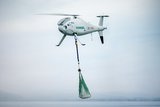Northrop Grumman poised to begin Titus UGV deliveries
Northrop Grumman has announced that its Remotec subsidiary will begin deliveries of the newest and smallest member of its Andros line of unmanned ground vehicles (UGVs) – Titus – in December. Details of the customer were not released in the 18 October announcement.
The Titus UGV has been designed for a variety of missions, and will bring a number of new capabilities to the small UGV market. According to the company, it was designed using a modular approach, which allows the robot to be quickly adapted for a variety of mission scenarios. Removable articulators, wheels and tracks provide users with the capability to navigate passageways that are only 16 inches wide and travel at a top speed of 7.5 mph. Industry standard interfaces such as USB and Ethernet make Titus easier to maintain and upgrade and to incorporate payloads and sensors.
The system weighs 135 pounds and measures 27 inches long, 16 inches wide and 23 inches high. It retains the four-articulator design that has given Andros vehicles advanced performance, and also features an operator control unit featuring a hybrid touch-screen and game system-style physical controls.
The company said attention has been paid to reducing life cycle costs, and to develop an operating system that provides greater information to the operator while easing user workload through more interactivity with intelligent payloads such as chemical, biological, radiological and nuclear sensors, along with preset arm positions and the ability to ‘fly the gripper,’ which makes manipulation of objects much easier.
Mike Knopp, director, Northrop Grumman Remotec, said that the feedback received so far from US and international military and first responders that have seen the system has ‘overwhelmingly validated’ that the company has achieved its objectives.
He added: ‘Titus represents the next-generation Andros. When we designed Titus, we challenged our engineers to not only retain certain capabilities but also to innovate and add capabilities – to really make the platform robust, highly functional and easy to use. They responded with a small UGV that was mechanically brilliant and re-imagined the entire user experience.’
More from Uncrewed Vehicles
-
Jammer resistant drone designs spark search for countermeasures
The Russia-Ukraine conflict has driven another stage of evolution for drones and the counter measures to defend against them.
-
![L3Harris launches Amorphous software for control of uncrewed platforms]()
L3Harris launches Amorphous software for control of uncrewed platforms
The new Amorphous software is a universal controller that would allow a single operator to control a swarm of “thousands” of uncrewed systems, from drones to underwater platforms.
-
ideaForge unveils new UAVs at Aero India 2025
India UAV supplier ideaForge has launched the Netra 5 and Switch V2 drones at Aero India 2025, boasting of enhanced endurance, AI-driven autonomy and improved operational capabilities.
-
![Shaping the future of defence: What 2025 holds for the global drone market]()
Shaping the future of defence: What 2025 holds for the global drone market
The UAV market is experiencing unprecedented growth, with innovations in technology and battlefield applications driving demand across military sectors. From the battlefields of Ukraine to NATO exercises and beyond, drones are transforming how wars are fought and supported.
-
![Maris-Tech confirms customers signing up for Jupiter Drones codec and AI-powered system]()
Maris-Tech confirms customers signing up for Jupiter Drones codec and AI-powered system
Launched at AUSA in October, the company’s multi-stream video codec is attempting to bring a new lease of life to drone technology through its AI accelerator.
-
![AUSA 2024: Quantum-Systems targets big 2025 with UAS developments]()
AUSA 2024: Quantum-Systems targets big 2025 with UAS developments
Quantum-Systems has been upgrading its UAS family, with new versions of the Vector, Reliant and Twister drones set for release throughout 2025.
























